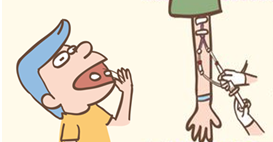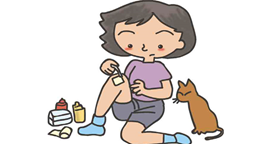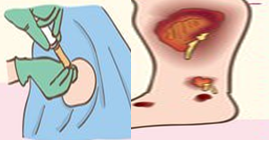【Learning Points】
- Cellulitis poses a high risk for certain groups, including individuals with weakened immune systems, poor blood circulation, susceptibility to wounds, and those who frequently irritate the skin.
- Clinical treatment for cellulitis includes oral or intravenous antibiotics, maintaining wound cleanliness with daily dressing changes, and, when necessary, undergoing surgical intervention
- Key points for at-home care of cellulitis involve maintaining cleanliness and dryness of the wound, practicing proper hand hygiene, consuming a high-protein diet, adhering to medication schedules, and attending follow-up appointments promptly.
I. What is Cellulitis?
Cellulitis is bacteria invade the skin tissues through a wounds and(dermis and subcutaneous tissues) release toxin. The growth in the tissue spaces and widely distributed, which can lead to inflammatory response.
II. Who is easy to get the cellulitis?
- People with poor resistance: the elderly, the use of immunosuppressive agents.
- Poor blood circulation: obesity, cardiovascular disease, poor liver function.
- People who are prone to wounds: tooth extraction, diabetes patients, kidney disease patients,Barefoot worker.
- Those who often irritate the skin: like to squeeze acne, like to wear shoes that do not fit well.
III. Clinical symptoms:
- Lesion may have different wound pattern according to bacterial strain. Sometimes, it doesn’t slow obvious margin.
- Infection site shows red, swollen, hot and painful, nodules sometimes appear in the infected area.
- Some patient may combine with fever, chills, general malaise, headaches or joint pain, if no adequate treatment, it may be further developed into gangrene, abscess or sepsis.
IV. Treatment:
 |
(A)
Apply ointment, oral or drip-injected antibiotics under the direction of a physician.
|
 |
(B)
If the infection site has the wound, it should be daily dressing and keep sterile.
|
 |
(C)
The patient has tinea pedis should clean his feet before applying ointment.
|
 |
(D)
If abscess formation, surgery such as drain or debridement should be considered.
|
V. Precautions:
- To avoid infection, please keep hands clean. If no necessary, do not touch the wound.
- Keep the environment clean, reduce the probability of cross contamination.
- Keep the wound and surrounding skin clean and dry.
- Using soft pillow to raise, reduce the red and swollen limbs.
- Encourage more bed rest, eating high protein diet (fish, poultry, pork, beef, eggs, dairy products) to increase immune system.
- Ice pack can be used to relieve pain with the permission of the doctor. Rest at least 30 minutes for 10 minutes ice pack, 4-6 times a day.
- Take the medicine and return to the doctor on time according to the doctor's instructions.
VI. Conclusion:
Cellulitis is a common acute infection disease and easy to recurrence, it is often accompanied by pain, and insufferable. Do not ignore small wounds, the early diagnosis and appropriate antibiotic treatment, have the good prognosis.
Cellulitis is a common acute infection disease and easy to recurrence, it is often accompanied by pain, and insufferable. Do not ignore small wounds, the early diagnosis and appropriate antibiotic treatment, have the good prognosis.
VII. References:
- 黃馨儀、江姿穎、高綺吟(2021)‧運用Swanson關懷理論於一位蜂窩性組織炎病人之護理經驗‧護理雜誌,68(1),97-103。https://doi.org/ 10.6224/JN.202102_68(1).13
- Todhunter, J. (2018). Diagnosis and management of lower limb cellulitis. Journal of Community Nursing, 32(1), 40–47. https://doi.org/ 10.7861/ clinmedicine.18-2-160
簡易測驗
Let us take the quiz to make sure you understand
評語
統計結果不開放
請登入後才可以評分
未登入或權限不足!
- 位置
-
- 資料夾名稱
- English
- 上傳者
- 黃郁琇
- 單位
- 中榮護理衛教
- 英文名稱
- Understanding Cellulitis
- 分類
- 疾病
- 科別
- 英語
- 癌症照護
- 否
- 建立
- 2024-01-22 22:26:06
- 制訂日期
- 2015-03-01
- 最近修訂
- 2024-03-21 14:01:00